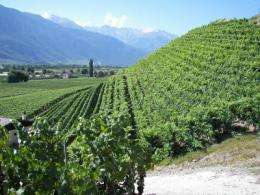First aid for winemakers

Whether or not a wine turns out to be as outstanding as the winemaker hopes depends on the quality of the yeasts; they control the fermentation process and create the distinctive flavor. A new sensor allows winemakers to establish whether the grape must contains the right sort of microorganisms before fermentation has even begun.
A good wine is unmistakable. It has its own particular taste, its own characteristic and singular aroma. None of this happens by accident: the production of quality wines is an art form in its own right. The vintner has to plant the right variety of grape, harvest and press it at just the right moment and store the grape juice properly for fermentation. "Even if you get everything right in the preparations, there's still an element of risk," explains Dr. Mark Bücking of the Fraunhofer Institute for Molecular Biology and Applied Ecology IME. It is not just location, type of grape and degree of ripeness that give a wine 'that special something'; the yeasts that are active during the fermentation process are just as important. These yeasts are microorganisms that occur naturally in areas where wine is produced. Each vineyard has a characteristic yeast population of its very own, and it is this that lends the wine its own distinctive flavor. Only those winemakers who use these wild yeasts for spontaneous fermentation are in with a chance of producing a truly top-class wine that will garner the praise and approval of connoisseurs.
Spontaneous fermentation is not without its risks, though, since not all wild yeasts have a positive effect on the development of a wine. There are some "bad guys" that can generate unpleasant flavors or even impede the fermentation process. Ex-perienced winemakers always keep a very close eye on the process so that they can add cultured yeasts if necessary. "Supplementing the wine in such a way has a detrimental effect on its quality, however, and the resulting wine is destined for mediocrity," says Bücking. The research scientist is not only a wine lover and connoisseur, but also an analytical specialist. He and his team have developed a prototype piece of equipment that winemakers can use to check whether the yeasts present in their wine must are indeed the right ones. The experts will be presenting their work at the Anuga FoodTec trade fair in Cologne from March 27 to 30, 2012.
The detector is no bigger than a cell phone, and fits into any trouser pocket. It contains ten little Plexiglas tubes, each coated with antibodies. The winemaker takes a pipette and fills the tubes with wine must, upon which any yeast that encounters a matching antibody on the walls of the tubes sticks to the sides. The ensuing biochemical reaction produces an easily recognizable color change: the little tube turns blue. "We can already detect half a dozen different types of yeast in a short space of time just using this prototype," explains Bücking. "Depending on what the winemaker wants, it's possible to analyze the 'good', sought-after yeasts or the 'bad', undesirable ones. The technology is very flexible; all you have to do is make the antibodies."
Apart from identifying "bad guys", the analytical technology can also be used to detect fungi, bacteria and viruses that cause diseases in plants, for example. Until now it was only big labs that could carry out such microbiological analyses. Sending them the samples and having to wait for these to be analyzed cost a lot of time. As Mark Bücking states: "Everything's much quicker with the new antibody testing kit. It's possible to carry out the test in situ and so save precious time."
Provided by Fraunhofer-Gesellschaft















